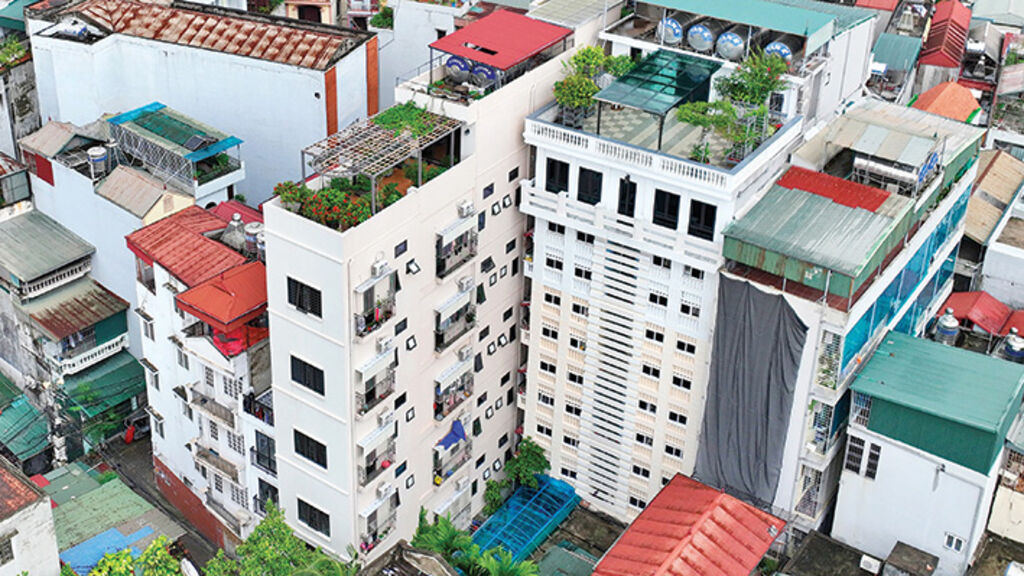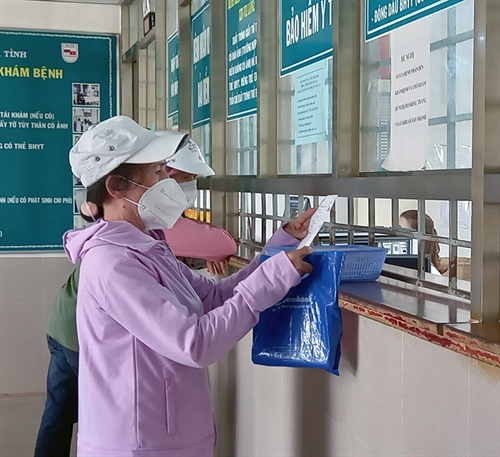 |
| Mini apartment blocks are booming in big cities__Photo: VNA |
Small-sized or mini apartment blocks have become popular to Vietnamese urban residents, especially those living in big cities like Hanoi and Ho Chi Minh City. Whereas mini apartment blocks, just like their names, are actually multi-story multi-household buildings, they are not subject to regulations applicable to condo buildings but are treated as individual houses. This gives rise to numerous issues, ranging from fire safety to legal risks to house buyers.
After months of probing into the housing market, Nguyen Thuy An, a 28-year-old office employee in Hanoi, and her husband decided to buy a mini apartment, i.e., an apartment in a small-sized apartment block, at the price of VND 1.1 billion (approximately USD 45.100). The building, with seven stories each having five apartments, a stairway and an elevator, was built on a land plot of 300m2 in a small alley of the inner district of Hoang Mai.
Thuy An and her husband are among hundreds of thousands of families for whom mini apartments seem to be the most suitable housing option. Mini apartments began to bloom in Vietnam in general and the capital city of Hanoi in particular since 2010, more than a decade ago. At that time, there were few commercial and social housing projects while the housing demand was great. Against that backdrop, mini apartments, with the price and location advantages, quickly became a very best-selling product in the real estate market.
Lack of official definitions
From a legal perspective, there are no official definitions of mini apartment and mini apartment building. The 2005 Housing Law said nothing about them. In fact, mini apartment buildings appeared for the first time when the Government issued Decree 71/2010/ND-CP detailing and guiding the implementation of the 2005 Housing Law, giving the green light for the development of individual houses designed in the form of multi-story houses with multiple self-contained apartments.
When the 2014 Housing Law was adopted to replace its 2005 version, mini apartments and mini apartment buildings were still neglected and classified into the group of individual houses of households and individuals. Notably, the Law contains a provision (paragraph 2 of Article 46.2) stating: “In case households and individuals are permitted to build houses with two or more stories each designed and constructed to have two or more self-contained apartments each meeting the minimum construction floor area standard, and with areas under private ownership and areas under common ownership of condominiums as prescribed by the Housing Law, their ownership of each individual apartment in such houses will be recognized by the State.”
It is such provision that serves as the legal foundation for the purchase and sale of mini apartments over the past years.
After the 2014 Housing Law was enacted, the Hanoi Municipal People’s Committee issued a decision under which the concepts of “mini apartment building” and “mini apartment” were mentioned for the first time. The decision, coded 24/2014/QD-UBND, stipulates that the Hanoi local administration will grant a house ownership certificate to each apartment of a mini apartment building if: (i) the apartment has a construction floor area of at least 30m2 and (ii) the building complies with the Housing Law’s provisions on condo buildings.
Arising issues
When it comes to mini apartment blocks, the first and foremost issue to be touched on is fire safety. The fire taking place in a nine-story apartment building in Thanh Xuan district, Hanoi, on September 12, which has killed 56 people so far, was the latest and most devastating event.
According to architect Dao Ngoc Nghiem, Vice President of the Vietnam Urban Planning and Development Association, mini apartment buildings are often built on small land plots located deep down narrow alleys in populated residential quarters where fire engines and appliances can hardly access. Some of them even lack emergency exits and fire prevention and fighting facilities. “When a building itself does not meet fire safety conditions, plus the fact that it is in a location inconvenient for emergency escape, the combination of the two factors will probably lead to unfortunate events,” Nghiem was quoted by the Thoi bao Kinh te as saying.
The mushrooming of mini apartment buildings also leads to the overload of urban infrastructure systems. The Ho Chi Minh City Real Estate Association (HoREA), in an official letter sent to the Ministry of Construction, cited the development of this house type as the cause of the increasing pressure on urban technical and social infrastructure systems which disrupts urban master plans and hinders urban embellishment work.
Mini apartment transactions also pose legal risks to house buyers.
In a talk with the Lao Dong newspaper, lawyer Bui Dinh Ung from the Hanoi Bar Association warned those who are considering buying mini apartments to be very careful, otherwise it is very risky.
As analyzed by lawyer Ung, in case apartment building owners are licensed to build houses designed in the form of multi-story multi-household apartment building, each apartment buyer will be granted a house ownership certificate, provided the apartment buildings comply with construction permits and fully meet the conditions listed in Article 70 of the 2014 Housing Law. If apartment building owners do not abide by construction permits or the apartment buildings fail to meet fire safety requirements, no house ownership certificate will be granted to apartment buyers.
Expert opinions
Experts have voiced their worry about the uncontrolled development of mini apartment buildings long before the occurrence of the fire disaster in Thanh Xuan, Hanoi. For the time being, when a new Housing Law is in the making and expected to be tabled to the National Assembly (NA) for passage at the upcoming October session, there are a lot of opinions that the new law should not legalize mini apartment buildings.
“It is necessary to prevent and restrict this house type”, said Nguyen Van Dinh, Chairman of the Vietnam Association of Realtors, calling mini apartments as “faulty products” that exert excessive pressure on urban infrastructure systems while creating tremendous safety risks.
Meanwhile, the HoREA suggested that state agencies use planning tools to control the development of individual houses built in the form of multi-story multi-household buildings.
As evaluated by architect Nghiem, the intermingling of multi-story buildings and individual houses in residential quarters is an inevitable trend in densely populated urban areas with a large number of migrants. However, the key issue is technical infrastructure conditions which must be taken into careful consideration. First of all, authorities should clearly define what mini apartments and mini apartment buildings are and determine areas where this house type is permitted and areas where it is banned. Once these regulations are enacted, all violations will be severely punished.
Addressing the NA Standing Committee’s meeting on September 20, NA Chairman Vuong Dinh Hue affirmed that the new Housing Law would absolutely not legalize mini apartments.
Earlier, Trinh Xuan An, a full-time member of the NA Committee for National Defense and Security, told the press that mini apartment buildings are entailing safety risks. “We should not support the construction of mini apartment buildings but, instead, ought to back the development of social housing projects for low-income earners,” he said.-









